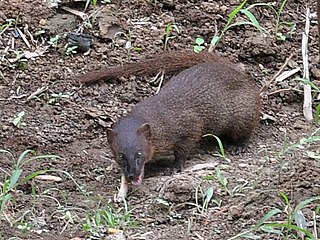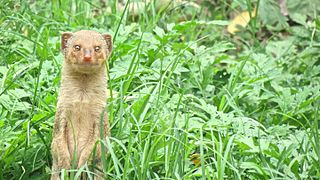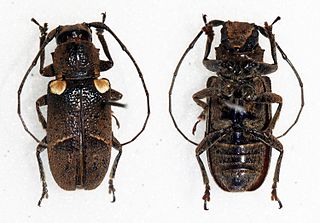
The lesser adjutant is a large wading bird in the stork family Ciconiidae. Like other members of its genus, it has a bare neck and head. It is however more closely associated with wetland habitats where it is solitary and is less likely to scavenge than the related greater adjutant. It is a widespread species found from India through Southeast Asia to Java.

The banteng, also known as tembadau, is a species of wild bovine found in Southeast Asia.

The Javan myna, also known as the white-vented myna, is a species of myna. It is a member of the starling family. It is native to Bali and Java. It has been introduced to other Asian countries, and as far away as Puerto Rico.

The Javan mongoose is a mongoose species native to Southeast Asia.

The Javan or Eastern pipistrelle is a species of pipistrelle bat found in South and Southeast Asia.

The giant moray is a species of moray eel and a species of marine fish in the family Muraenidae. In terms of body mass, it is the largest moray eel; however, the slender giant moray is the largest in terms of body length.

The Javan plover is a bird species in the family Charadriidae. It is endemic to Indonesia, where it inhabits sandy shores and intertidal mudflats. It is threatened by habitat loss and is listed as Least concern on the IUCN Red List. It forages for food in mudflats.

The red-billed malkoha is a species of cuckoo in the family Cuculidae. It is found in Brunei, Indonesia, Malaysia, Myanmar, and Thailand. Its natural habitat is subtropical or tropical dry forests.

The Javan slow loris is a strepsirrhine primate and a species of slow loris native to the western and central portions of the island of Java, in Indonesia. Although originally described as a separate species, it was considered a subspecies of the Sunda slow loris (N. coucang) for many years, until reassessments of its morphology and genetics in the 2000s resulted in its promotion to full species status. It is most closely related to the Sunda slow loris and the Bengal slow loris (N. bengalensis). The species has two forms, based on hair length and, to a lesser extent, coloration.

The Java mouse-deer is a species of even-toed ungulate in the family Tragulidae. When it reaches maturity it is about the size of a rabbit, making it the smallest living ungulate. It is found in forests in Java and perhaps Bali, although sightings there have not been verified.

Tragulus is a genus of even-toed ungulates in the family Tragulidae that are known as mouse-deer. In Ancient Greek τράγος (tragos) means a male goat, while the Latin diminutive –ulus means 'tiny'. With a weight of 0.7–8.0 kg (1.5–17.6 lb) and a length of 40–75 cm (16–30 in), they are the smallest ungulates in the world, though the largest species of mouse-deer surpass some species of Neotragus antelopes in size. The mouse-deer are restricted to Southeast Asia from far Southern China to the Philippines (Balabac) and Java.

Xenodermus javanicus, also known as the dragon snake, Javan tubercle snake, Javan mudsnake, or rough-backed litter snake, is a small non-venomous, semi-fossorial snake species belonging to the monotypic genus Xenodermus. This species is best known for their characteristic dorsal scales and interesting defense mechanism in which they stiffen their entire bodies when threatened. X. javanicus is nocturnal and subsists on a diet of frogs, tadpoles and small fish. They most often perish once placed into captivity; only a few herpetoculturists have been successful in keeping them.

The elephant trunk snake or the Javan file snake, is a species of snake in the family Acrochordidae, a family which represents a group of primitive non-venomous aquatic snakes.

The small Indian mongoose is a mongoose species native to Iraq and northern India; it has also been introduced to several Caribbean and Pacific islands.

Prosoplus is a genus of longhorn beetles of the subfamily Lamiinae, containing the following species:
Prosoplus atlanticus is a species of beetle in the family Cerambycidae. It was described by Stephan von Breuning in 1938.
Prosoplus costatus is a species of beetle in the family Cerambycidae. It was described by Karl-Ernst Hüdepohl in 1996. It is known from Borneo and Malaysia.
Prosoplus lividus is a species of beetle in the family Cerambycidae. It was described by Masaki Matsushita in 1935.
Prosoplus sinuatofasciatus is a species of beetle in the family Cerambycidae. It was described by Blanchard in 1855.

Cyperus javanicus, also known as the Javanese flatsedge, is a sedge of the family Cyperaceae that is native to Indonesia and Australia.















